Google Nexus 5 Review
by Brian Klug on December 5, 2013 8:00 AM EST- Posted in
- Smartphones
- LG
- Android
- Mobile
- Snapdragon 800
- Android 4.4
- Nexus 5
It goes without saying that battery life is one of the huge cornerstones of smartphone evaluation and critique. In the case of Nexus 5, the battery is a 3.8 V, 2300 mAh 2D battery giving 8.74 watt hours total. Looking only at battery capacity doesn’t always tell the whole story, since obviously it’s just a tank to draw from – the overall efficiency of the entire system and the sum of the energy drain of its parts determines how long the platform will last. The comparison point of course for the Nexus 5 is its close cousin, the LG G2, which has a 3000 mAh (11.4 Whr) stacked (3D) battery by LG Chem. Smartphone battery sizes have been increasing for a while now, and the reality is that Nexus 5’s is indeed on the smaller side given its display.
As I’ll talk about later, one thing the Nexus 5 has over the LG G2 is a QFE1100 envelope tracker for its cellular power amplifiers, which lowers power consumption by up to 20 percent, the same RF360 part we saw in the Galaxy Note 3. Interestingly enough the LG G2 shipped with a variant of this same family, QFE1101, which works in an APT (Average Power Tracker) mode instead, whereas QFE1100 works in both APT and ET modes. I’ll touch on these in the relevant section, but it’s important to note that in the cellular tests one of the big consumers of power (power amplifiers are easily the number two after display) has the bleeding edge component available to curb consumption and is literally the second handset on the market to include it.
To evaluate battery life we turn to our battery life testing suite, which we run over WiFi and all the cellular interfaces appropriate for the device. Here we see a good combination of regular spikes in CPU usage with idle time, hopefully simulating constant, reasonably paced usage. As always the display is set to exactly 200 nits and configured the same way we always configure devices for maximum consistency.

On WiFi, we see the Nexus 5 start off pretty well, behind the G2 and the newest 8974 phones, but no slouch at all, and considerably better than the Nexus 4. Of interest is how the Nexus 5 slips 16 percent versus the G2 despite having a 23 percent smaller battery.
For cellular, it’s the same workload as always. Since the Nexus 5 now has LTE, I went back and re-tested the Nexus 4 with LTE enabled for a closer comparison. Although the Nexus 4 never shipped with LTE officially enabled, the device included it on Band 4 for some time until a baseband update finally locked it out for good. I flashed back down and ran the test just for the sake of completeness, and since I Know there are a fair amount of people out there using the Nexus 4 on LTE still. Of course I also tested on 3G WCDMA.
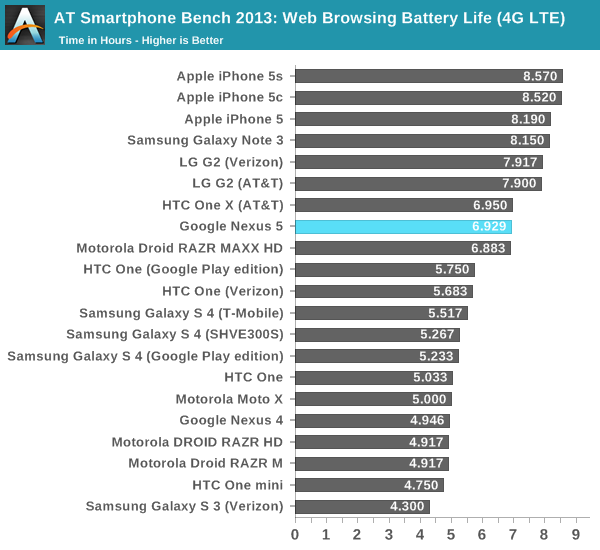

The Nexus 5 comes out far ahead of its predecessor on both 3G WCDMA and 4G LTE, although that’s fairly unsurprising given the year of improvement, different process (28nm HPM), envelope tracking, and battery size differences. The more interesting comparison point is the LG G2, which Nexus 5 can’t quite catch. Clearly the RF front end differences make a difference, otherwise the scaling would be 23 percent less battery on cellular, instead it is 12 percent on LTE. On 3G there’s a bigger delta however, almost 33 percent worse than the G2’s impressive result. Still, the Nexus 5 on LTE is no slouch.
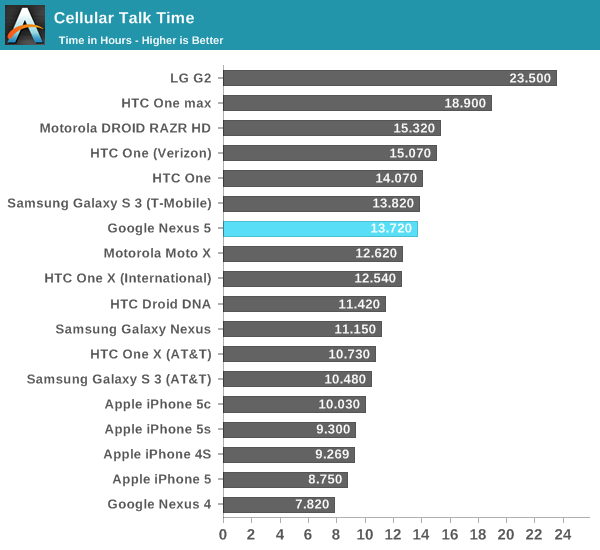
In the talk time test I was surprised to see a considerable falloff, although this is almost always gated by rock bottom power for the system. There clearly are some other consumers which either aren’t powering down all the way or LG has better optimized for on the G2 versus the Nexus 5 which is Google’s domain.
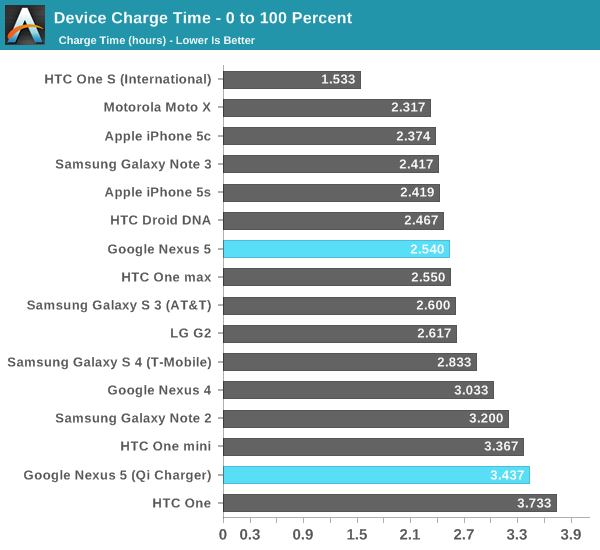
Looking at battery capacity alone would leave you with the impression that the Nexus 5 is woefully under-specced, when in reality battery life shows definite gains over previous generation devices. Although I’d love if the device somehow had the same size battery as the G2, it’s clearly enough to make it through at least a full day, and in my time daily driving the device I’ve yet to come up short.
When it comes to charging, Google continues to do the sane thing and implement BC 1.2 signaling. Unlike the LG Optimus G, the Nexus 5 does not use the battery charging IC Qualcomm makes for use in conjunction with its normal PMICs, instead it uses the TI BQ24192 to charge at up to 1.5 A maximum and a MAX17048 fuel gauge. This seems to be done in order to accommodate wireless charging, though there could be other cost considerations at play. The Nexus 5 seems to charge in the linear region at just above 1 A however, although the limit set for BQ24192 is 1.5 A, and has a total charge time just above 2.5 hours on the supplied 1.2 A charger.
As I mentioned, Nexus 5 also works with the Qi (prounounced “chee”) wireless charging specification which Google seems to have thankfully settled on for Nexus 4, 7, and now 5. The Nexus 5 uses TI’s bq51013b power supply and charge receiver which is WPC 1.1 compliant. I praised the Nexus 4 for how well implemented Qi charging was and how it charged in basically the same amount of time on the charging mat or USB, as far as I can tell the Nexus 5 continues to implement things properly and will charge at accelerated rates. I’ve seen a few handsets that include Qi but oddly enough only charge at 500 mA like a USB data port, this is thankfully not the case on Nexus 5.
Nexus Wireless Charger
Google sent along their first party Qi wireless charger as well and I had a chance to check it out. I’ve never used the charging “Orb” that shipped with Nexus 4 so I can’t comment on it, I have however used the two-position Energizer Qi charger and the Samsung Qi charger pad. Google’s universal Nexus wireless charger works with the other Qi compatible Nexus devices, Nexus 7 (2013), 4, and 5, and of course any Qi compliant devices. I tested with the Droid DNA and had no issues charging like any other Qi charger.
Google’s charger works in conjunction with a 9 Watt USB AC adapter and plugs into the charging puck over microUSB. What’s interesting about the charger is both how small it is (the outline is quite small) and how the bottom has a material that seems eerily reminiscent of what was on the bottom of the touchstone charger that shipped with the Palm Pre. The charger will securely adhere itself to surfaces, which it needs to since it has some magnets inside for alignment of devices.

I put some magnetic field viewing film on top of Google’s wireless charger, and you can see four magnets at the corners, which match up nicely with the four metal slugs on the back of the Nexus 5 around the charging coil.
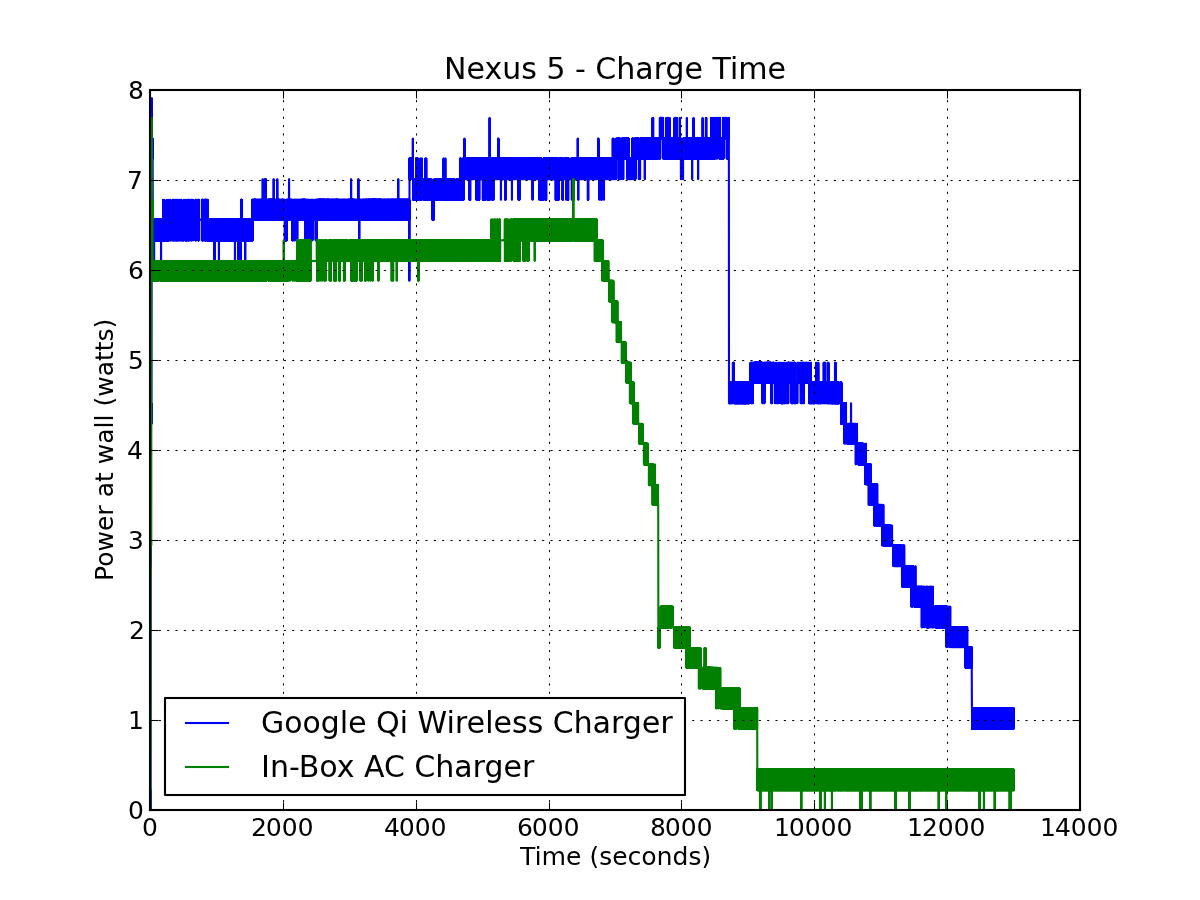
There’s still some overhead and loss with all wireless charging, including Qi. I measured and plotted the power draw and thus charge time for a fully drained Nexus 5 being charged both using the in-box supplied AC charger from Google, and their wireless charger. There ends up being about a 50 minute difference between the two, so you’re definitely trading convenience for a longer charge time, but once you’ve used wireless charging it’s hard to give up that convenience. At the very least, Google’s new charger addresses some of the complaints I saw levied against the original charging Orb with the inclusion of magnets that do seem to hold down devices better and keep them aligned so they charge properly, and included a very good grippy material on the back that adheres it to surfaces quite nicely.


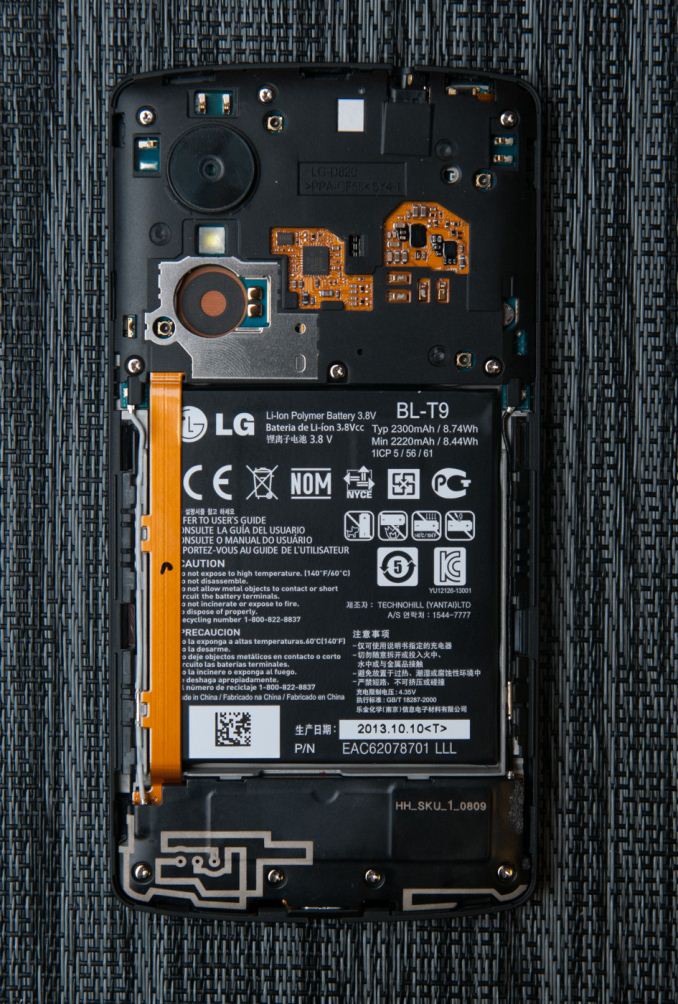
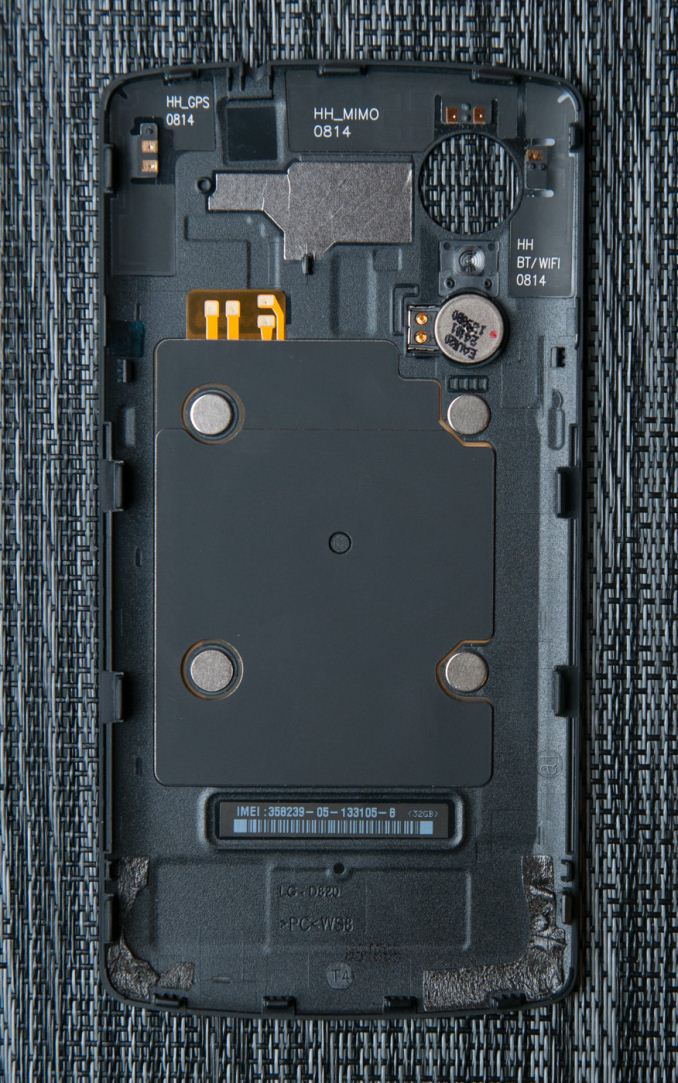
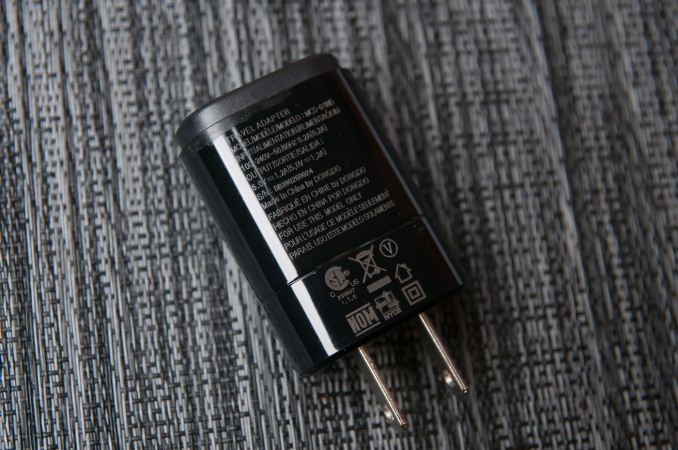
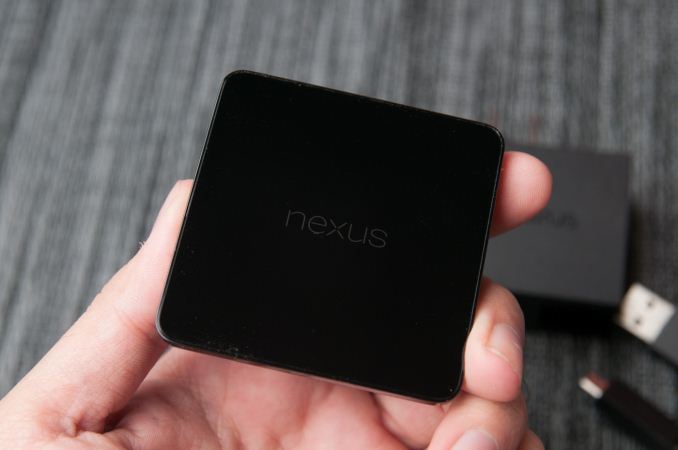














231 Comments
View All Comments
Pr3ch34r - Thursday, December 5, 2013 - link
Not-everyone-buy-a-nexus-for-300-fucking-dollarsPr3ch34r - Thursday, December 5, 2013 - link
I think he hit the jackpotffh2303 - Thursday, December 5, 2013 - link
About the charging time,my unit [a black 32GB D820] charges in under 90 minutes using a 2A Note 2 charger [Samsung ETA-U90UWE] while on. Using the Battery Monitor Widget by 3c I observed that while idling on the homescreen the phone consumes around 450mA [shown as -445mA in the app] and when I plug in the Note 2 charger it shows the phone is charging at around 1500mA [shown as +1500mA]. My charging time with the stock LG charger is the same as your findings though.rxzlmn - Thursday, December 5, 2013 - link
I wonder why the reported times from the battery life benchmarks are so much higher than any of the reported screen-on times in 'real-world' usage? I am not trying to discredit the data, just honestly curious. How does one get close to 9 hours of constant screen-on time while the phone is being used, and why is there not a single battery stat from phones in use anywhere close to that number?On a side note, do you plan on reviewing the Sony Z1? I am asking because it has generally received mixed reviews in terms of battery life, but actually seems to perform very good in 'real life' scenarios.
sherlockwing - Thursday, December 5, 2013 - link
Anandtech is one of the few sites that set all phone to the same brightness(200nits) when battery testing. What you see from other websites is that they test every phone at their auto-brightness or max brightness setting. That's why Anandtech's battery life benchmark results are different from other sites.rxzlmn - Thursday, December 5, 2013 - link
I'm talking about real usage, i.e. people who own the phone post screenshots of Android battery usage stats. Not benchmarks. The best you see for the N5 is 5 hours+, even with WiFi only.sherlockwing - Thursday, December 5, 2013 - link
Ofc having the phone run benchmark is going to result differently than real life usage since the scenario is different.Cinnabuns - Thursday, December 5, 2013 - link
The tests performed here are controlled and I imagine that the phone is not being moved around a whole lot during battery-life testing (and it shouldn't be). However, one of the nicest things about having a smartphone are location-aware services. And they drain the battery. A lot.Unfortunately, one of the biggest culprits is Google's own location reporting service, which itself is integral to various Google Now features.
Of course, there are also various bugs that people in the real world encounter that are not triggered by the very specific test conditions in the battery life tests here. For example, Android 4.3 had a bug that could cause a phone to never "deep sleep" after wireless charging. But there's really no way for a review site to try to hunt down all the battery bugs and reproduce them. That's not really within scope of a battery life test and reviewers aren't paid to do QA on a phone, so they can only report on specific bugs they encounter in their personal use of the device (or bugs that are so heinously obvious that everybody has heard about already).
In short, there's no way a review site knows what YOUR "real-world" usage is. So the best thing they can do is to perform a controlled study with a published methodology and report the results. You get to interpret whether that methodology can be extrapolated to your own "real life" use. Sadly, other "review" sites somehow extrapolate their own unscientific experience as representative of real life usage when in truth, there is no universal real-lifeusage.
Impulses - Friday, December 6, 2013 - link
At the end of the day what matters most is that AT's testing is under controlled circumstances SMS repeatable, thus you get a very fair relative comparison between the tested phones. You may not get 9 hours on wifi if you aren't sitting next to the router, at X brightness, with zero background syncs, etc etc; but you can easily tell whether phone A will so better than phone B based on their tests. Isn't that all that really matters when you're trying to decide whether to buy A or B?Impulses - Friday, December 6, 2013 - link
SMS = andWTB comment edit